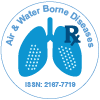Yan DUnderstanding Vector-Borne Diseases: Threats, Prevention, and Future Outlook
Received Date: Feb 01, 2024 / Accepted Date: Feb 29, 2024 / Published Date: Feb 29, 2024
Abstract
Vector-borne diseases (VBDs) continue to pose significant challenges to global public health, particularly in regions with limited resources and those experiencing rapid urbanization and climate change. These diseases, transmitted by vectors such as mosquitoes, ticks, and sandflies, have wide-ranging impacts on human populations, including morbidity, mortality, economic burdens, and societal disruption. This abstract provides a comprehensive overview of vector-borne diseases, covering their epidemiology, transmission dynamics, ecological determinants, and control strategies. Epidemiologically, VBDs are influenced by factors such as vector abundance, pathogen prevalence, host susceptibility, and environmental conditions. The transmission dynamics of VBDs are complex and can vary based on the interactions between vectors, pathogens, and hosts, as well as human behavior and interventions. Ecological determinants, including climate, land use, and biodiversity, play crucial roles in shaping the distribution and intensity of VBD transmission. Various control strategies, including vector control measures, vaccination, and community-based interventions, are essential for mitigating the burden of VBDs. However, challenges such as insecticide resistance, limited access to healthcare, and socio-economic disparities hinder effective control efforts. Addressing these challenges requires interdisciplinary approaches, collaboration between stakeholders, and investments in research, surveillance, and public health infrastructure. By enhancing our understanding of the drivers of VBD transmission and implementing integrated control strategies, we can mitigate the impact of these diseases and improve health outcomes globally.
Vector-borne diseases (VBDs) constitute a significant public health challenge worldwide, particularly in regions with favorable environmental conditions for vector proliferation. These diseases, transmitted to humans and animals by arthropods such as mosquitoes, ticks, fleas, and sandflies, have historically inflicted substantial morbidity and mortality, affecting millions annually. Vector-borne pathogens encompass a diverse array of microbes, including bacteria, viruses, protozoa, and helminths, each posing unique epidemiological and clinical complexities. Understanding the ecological, socio-economic, and climatic factors influencing vector distribution and disease transmission is paramount for effective VBD control and prevention strategies. Rapid urbanization, globalization, and climate change have further complicated the dynamics of VBDs, altering vector habitats and expanding the geographic range of many diseases. Consequently, interdisciplinary approaches integrating epidemiology, entomology, ecology, climatology, and social sciences are essential for mitigating the burden of VBDs.
Citation: Yan D (2024) Yan DUnderstanding Vector-Borne Diseases: Threats, Prevention, and Future Outlook. Air Water Borne Dis 13: 220.
Copyright: © 2024 Yan D. This is an open-access article distributed under the terms of the Creative Commons Attribution License, which permits unrestricted use, distribution, and reproduction in any medium, provided the original author and source are credited.
Share This Article
Open Access Journals
Article Usage
- Total views: 557
- [From(publication date): 0-2024 - Apr 11, 2025]
- Breakdown by view type
- HTML page views: 371
- PDF downloads: 186
